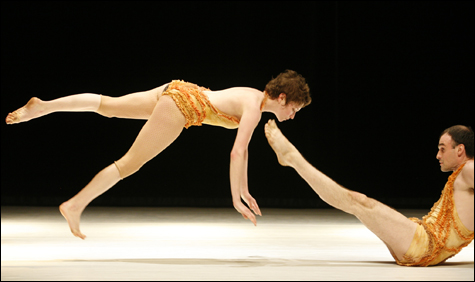
THROW PEOPLE: Desperate entities straining ineffectually toward one another.
|
Like its name, Misnomer Dance Theater seems devoted to contrariness. Whatever the rules of dancing or human encounter are supposed to be, choreographer Chris Elam finds 50 ways to subvert them. Misnomer returned to Concord Academy Summer Stages Dance a week ago Thursday, opening another intriguing series of July performances there.
As Elam describes his intentions, he likes to see how people function when they subject their bodies to extreme stress. This doesn’t translate into the kinds of acrobatic derring-do you see elsewhere on our dance stages. Misnomer dance is a struggle to accommodate to the impossible — after first having set up one’s own impossible circumstances. It’s a kind of counter-physicality that they exploit. The dancers never conquer the detours and distortions they’ve engineered, but they keep earnestly trying out new solutions. You get quite fond of their machinations.
Elam demonstrates the rigors of this struggle in the solo Tin Man. Planted on one bent leg with the other leg crossed over his knee, he balances for a long time, his arms, hands and fingers clutching out in improbable directions. Still folded up, he attempts a few steps, hopping on the one leg and using one fist like a cane. He angles out and twists in around his body with his arms. When he finally manages to stand upright, he sees a giant shadow of himself on the backdrop. He gazes up at it for a while, shrinking away a little, as if from a severe judge. Then he folds up again and ends the dance squatting over the other foot, which is stretched in relevé.
Elam says that Land Flat and Throw People were partly inspired by cockfighting. By putting the dancers in ongoing conflict with themselves and their companions, he hopes to induce primal states of hyper-awareness. Throughout both dances, they regard one another with curiosity, desire, aloofness, alarm, a whole gamut of feelings that their bodies can’t completely implement.
The four women in Land Flat (Brynne Billingsley, Jennifer Harmer, Coco Karol, and Dorian Nuskind-Oder) dance a kind of anti-ballet, at first pulled up and breathless, tiptoeing demonstratively around like swans on guard. They group and regroup in formal floor patterns, drawn together but pulled apart by the skewed disturbances that rack their bodies. They bourrée all bent over, reach out in contradictory directions, do high kicks with their shoulders hunched and their faces thrust forward. They dance bizarre, stressful duets and individual but fathomless solos.
They glide together into a clump, and as they reach away, resisting and clinging to each other, a romantic piece of music breaks off and the lights go out.
Karol, Elam and Luke Gutgsell become even more desperate entities, straining ineffectually toward one another, in Throw People. Elam scurries around, stiff-legged, tight-shouldered, like a ballet dancer imitating a person running. Karol submits to his amiable abuse, letting him bundle her over his shoulders and sling her sideways. Without changing her guileless expression, she retaliates by batting him in the face now and then.
Gutgsell patrols the edge of their space, looking mystified and twiddling his fingers as if searching for some occult communiqué. Then he steps out of his coverall and emerges costumed like the other two, in a peculiar body suit trimmed with crinkles. He and Karol dance together, and the three of them recombine in new extremes of dissonance. At one point, Elam picks up the other two — I think they’re stretched in arabesque at the time. They slink around one another’s bodies, get dropped on the floor. Elam hangs upside down by the knees from Gutgsell’s shoulders, making monster growls and futile scrabbling gestures.
Karol pulls Elam from one of these tangles and starts to lead him away in a sketchy foxtrot. Like everything else they did at Concord, this overture was left unresolved. The dance ended, but they could have kept on for hours without running out of moves.